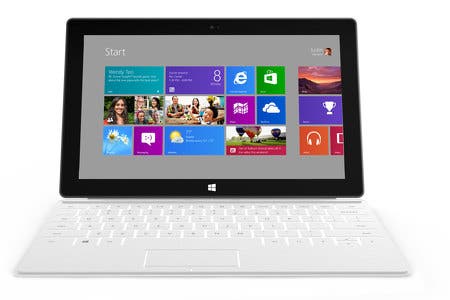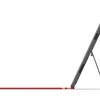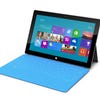Spec Analysis: Microsoft Surface
Digital Foundry's take on Microsoft's daring challenge to both iPad and MacBook Air.
Apple likes to talk about "magic" in its major keynote presentations. In last night's Microsoft reveal for the new Surface tablets, the keywords were "perfect" and "perfection". While operational faux pas swiftly put paid to these lofty aspirations, Surface certainly looks exciting: quality screens, ultra-thin magnesium casings, innovative keyboards, and built-in kickstands all present a level of finish that compared favourably with the best. Meanwhile, the functionality advantages of the Windows OS position Surface as being equally adept at productivity as well as consumption.
The overall response to the offering from social media, bloggers and on-site commentators seemed refreshingly positive for the most part. Surface isn't just a me-too knock-off of the all-conquering iPad, but a genuine fusion of tablet and PC that offers something fresh and new: a level of functionality beyond Apple's superb offerings. And in the face of a lukewarm response to date, Windows 8 itself suddenly looks a whole lot more interesting.
Two Surface models take aim at two very different market sectors: the entry-level RT model offers a form factor much like the latest iPad, with modest weight and depth reductions, and a UI that centres on the Windows 8 "Metro" tile-based system. A traditional Windows desktop is apparently available on the RT build of the OS, but third-party applications cannot be installed using it - everything needs to go through the Windows Store with approvals by Microsoft.
In effect, it is mirroring Apple and its iTunes App Store here, but the inclusion of a microSD slot and a USB 2.0 port offers up the prospect of a system that at least allows you access to your own files in a more convenient format. There are also reports that some kind of implementation of Adobe Flash allows white-listed sites to support non-HTML5 video too.
If the Surface RT aims to tackle the iPad, the more expensive Pro model seeks to bridge the divide between the tablet and Apple's Macbook Air products. Low-power ARM architecture is discarded in favour of an Intel Core i5 Ivy Bridge processor, offering a full, unfettered desktop version of Windows in addition to the Metro interface. Connectivity is boosted with USB 3.0, and the screen is upgraded to full 1080p at the same 10.6-inch form factor. The device is a little deeper, using a tiny full-perimeter seam in the magnesium casing to allow for airflow.
Surface: Gaming Credentials
Microsoft was deliberately - and annoyingly - light on actual tech specs, which makes assessment of the gaming capabilities of the machines challenging. However, we can make a few educated guesses.
Firstly, with the RT model, NVIDIA's Tegra technology was name-checked, and bearing in mind the processing load we can expect from a full Windows OS along with the fact that the unit is launching alongside Windows 8 within months, we should reasonably expect to see the quad-core Tegra 3 in the tablet. In terms of raw benchmarks, the quad CPU configuration outclasses the dual-core A9s in Apple's A5, but raw 3D potential in existing tests is significantly behind both A5 and A5X. Swings and roundabouts, perhaps, but typically speaking, GPU power is more important to cutting-edge mobile games.
"Surface RT presents itself as a genuine iPad challenger, while the Pro model offers full PC power in a tablet form factor just 13.5mm thick."
However, Microsoft's reluctance to name the processor directly, in combination with its obvious hunger to challenge Apple, could mean that NVIDIA's Tegra 3+ revision is on the table, described by general manager Mike Rayfield as a "high performance" part and a "pretty significant bump" over the current hardware.
With the Surface Pro, Microsoft has been rather more overt about the technology used, specifically identifying the current Intel Ivy Bridge Core i5 processor - almost certainly the more slowly clocked, ultra-low-voltage (ULV) version of the architecture, as used in the MacBook Air and Intel's own Ultrabook platform. Ivy Bridge contains its own onboard graphics processor - the Intel HD4000 - a DirectX 11 capable part that can handle the latest games, but only with a limited degree of raw performance.
As a gaming platform, Anandtech's Core i5 Ivy Bridge Ultrabook analysis sums up that recent games running on low and medium presets struggle, even at 1366x768 resolution, with Batman: Arkham City averaging at 32FPS, while Battlefield 3 operates at around half that frame-rate. For titles running from the Windows Store and based on the RT framework, it should offer more than enough horsepower, while older PC titles should also work reasonably well too.
It's difficult to avoid the conclusion that, from a hardcore gaming perspective, Surface arrives a generation too early. Tegra 3 has acknowledged weaknesses against both iPad 2 and iPad 3 graphics cores: if Tegra 3+ is indeed in the new tablet, that could help, but it's the 2013 NVIDIA parts that offer the true generational leap that changes the game.
With the Intel-based Surface Pro, next year's "Haswell" refresh is rumoured to feature a 2x to 3x performance boost over the current Ivy Bridge. Looking once again at Anand's tests, this puts integrated graphics performance up there with the Acer Timeline Ultra M3, which we evaluated just a couple of days ago as a worthy games machine capable of some surprisingly decent performance, even on the heaviest PC gaming titles. That kind of gaming potential in a 10-inch tablet would be simply phenomenal, and as the "tock" in Intel's tick-tock approach to revising hardware, it would be another two years before performance sees another big bump.
Surface: The Prospects
The new Microsoft tablet faces obvious challenges in terms of the iPad's quality and dominance and the Android tablets' diversity and entry-level value, but it is clear that the firm itself reckons that the iPad is the principal rival.
The pitch is that the device offers similar levels of build quality to the Apple product, consumes media and the internet just as voraciously, while providing extra options in terms of functionality. Microsoft Office should be in there as standard, the ultra-thin magnetic snap-on keyboards look promising, and, driver support permitting, the USB slot opens up a whole new world of connectivity that you don't have on Apple's devices. MicroSD expansion ensures you won't be artificially held back from adding more memory or easily getting at your content.
There are a number of concerns though. With the iPad 2 and "new iPad", Apple offers simply stunning products at two price points, with market-leading app support and superb battery life. Crucially, Microsoft omitted all mention of battery stamina from its presentation. Hopefully it should be competitive: Tegra is whole lot smaller than both A5 and especially A5X, while the lack of Retina display on the Surface RT should also ease the load on battery life. A 31.5Wh battery up against the 42.5Wh in the latest iPad offers the suggestion that it will be competitive once Surface's lower-power parts are factored into the equation, and NVIDIA's own presentations make some bold claims for RT stamina.
"How much does it cost? How long will it last? How much RAM does it have? Microsoft's bizarre omission of basic specs prompts us to suspect the worst - not the smartest move."
The other sticking point is price. For all the extra value it may offer in terms of functionality, the bottom line is that Surface RT needs to significantly undercut the latest iPad. Hopefully the lack of 1080p screen and the miniscule size of the Tegra SoC offers the scope for a competitive price point.
The Surface Pro had the wow factor, effectively combining full PC functionality into a dinky tablet form factor that gives the MacBook Air a run for its money in terms of overall desirability. Having worked recently with the older Core i5 Sandy Bridge ULV processor for our Acer Timeline Ultra M3 review, there are zero complaints about the unit's smoothness or functionality in general OS tasks, and the notion of an improved version of that tech shrunk down into a 10-inch tablet with a proper 1080p screen is highly compelling.
But once again, battery life remains a genuine concern and the lack of specs on processor speed and the amount of system RAM are irritating. By not relaying crucial information, Microsoft is inviting people to think the worst, when a little digging asuggests it will be competitive - the battery is 42Wr, so slightly bigger than the cell inside the 11-inch MacBook Air, but smaller than the 13.3-inch unit. A good six to seven hours of basic usage therefore seems reasonable.
Bearing in mind how desirable the Pro model is, only vague allusions to its price point were also frustrating. In only offering nebulous comparisons to existing Ultrabook prices, Microsoft basically suggests that the Surface Pro could cost anything from £800 to £1200.
Perhaps more important than these issues is that Microsoft needs to create a product that demonstrably works - and does so flawlessly. Windows 8 previews for desktop have revealed a UI that confuses many, and this keynote presentation did the OS no favours: the RT tablet crashed while doing nothing in particular and even Microsoft staff appeared to have genuine issues in making the UI do what they wanted it to do. When attempting to demonstrate NetFlix, the interface looked unresponsive and the video didn't seem to stream at all.
"I say 'perfect' a lot, I say 'perfectly' a lot. It's part of our team culture... we strive for perfection on every sub-component of this product," says Surface team leader, Panos Panay.
While the hardware propositions looked compelling, it's a shame that the software couldn't match Microsoft's aspirations on the day. Let's hope that the final product addresses these issues comprehensively.













.png?width=291&height=164&fit=crop&quality=80&format=jpg&auto=webp)
